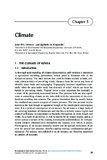Chapter 5 – Climate

View/
Date
2013Author
Obiero, John PO
Onyando, Japheth O
Type
Book chapterLanguage
enMetadata
Show full item recordAbstract
Climatic characteristics, factors influencing them and effects on agro-climatic zonation and crop productions is discussed. It is recognized that climate plays a key role in agricultural production which is the mainstay of the Kenyan economy. Factors influencing climatic characteristics are notably latitude, altitude, characteristics of prevailing winds, distance from water body, topography, vegetal cover and pressure belts. Air masses, their sources and influence on dry and rainy seasons for various regions of the country are described. Rainfall and temperature distribution in various parts of the country are observed to have significant influence on agricultural practices. Variations in rainfall and temperatures are attributed to differences in characteristics that influence these climate variables. Subsequently, seven climatic regions are identified as residing in various sections of the country. Based on rainfall and temperature which determine moisture availability and evaporation rates, distinct agro-climatic zones are have been established and which play a significant role in determining appropriate land use practices for various regions of the country as well as serving as a tool for assessing suitable crops to be grown in these distinct zones. The effects of climate extremes resulting into natural disasters like floods and droughts are further discussed and strategies for their management proposed to minimize their effects on agricultural production. The role of meteorological network in monitoring weather information is noted to be important for predicting weather related disasters.
URI
http://www.sciencedirect.com/science/article/pii/B9780444595591000050http://hdl.handle.net/11295/66305
Citation
Developments in Earth Surface Processes Volume 16, 2013, Pages 39–50 Kenya: A Natural Outlook — Geo-Environmental Resources and HazardsPublisher
University of Nairobi
